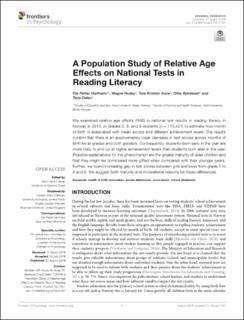| dc.contributor.author | Vestheim, Ole Petter | |
| dc.contributor.author | Husby, Magne | |
| dc.contributor.author | Aune, Tore Kristian | |
| dc.contributor.author | Bjerkeset, Ottar | |
| dc.contributor.author | Dalen, Terje | |
| dc.date.accessioned | 2020-06-16T07:36:45Z | |
| dc.date.available | 2020-06-16T07:36:45Z | |
| dc.date.created | 2019-07-15T17:35:58Z | |
| dc.date.issued | 2019 | |
| dc.identifier.citation | Vestheim, O. P., Husby, M., Aune, T. K., Bjerkeset, O. & Dalen, T. (2019). A population study of relative age effects on national tests in reading literacy. Frontiers in Psychology, 10: 1761. doi: | en_US |
| dc.identifier.issn | 1664-1078 | |
| dc.identifier.uri | https://hdl.handle.net/11250/2658189 | |
| dc.description.abstract | We examined relative age effects (RAE) in national test results in reading literacy in Norway in 2013, in Grades 5, 8, and 9 students (n = 173,421) to estimate how month of birth is associated with mean scores and different achievement levels. The results confirm that there is an approximately linear decrease in test scores across months of birth for all grades and both genders. Consequently, students born early in the year are more likely to end up at higher achievement levels than students born later in the year. Possible explanations for this phenomenon are the greater maturity of older children and that they might be considered more gifted when compared with their younger peers. Further, we found increasing gap in test scores between girls and boys from grade 5 to 8 and 9. We suggest both maturity and motivational reasons for these differences. | en_US |
| dc.language.iso | eng | en_US |
| dc.publisher | Frontiers | en_US |
| dc.rights | Navngivelse 4.0 Internasjonal | * |
| dc.rights.uri | http://creativecommons.org/licenses/by/4.0/deed.no | * |
| dc.title | A population study of relative age effects on national tests in reading literacy | en_US |
| dc.type | Peer reviewed | en_US |
| dc.type | Journal article | en_US |
| dc.description.version | publishedVersion | en_US |
| dc.rights.holder | © 2019 The Author(s) | en_US |
| dc.subject.nsi | VDP::Samfunnsvitenskap: 200::Pedagogiske fag: 280::Allmennpedagogikk: 281 | en_US |
| dc.subject.nsi | VDP::Samfunnsvitenskap: 200::Psykologi: 260 | en_US |
| dc.source.pagenumber | 7 | en_US |
| dc.source.volume | 10 | en_US |
| dc.source.journal | Frontiers in Psychology | en_US |
| dc.identifier.doi | 10.3389/fpsyg.2019.01761 | |
| dc.identifier.cristin | 1711548 | |

